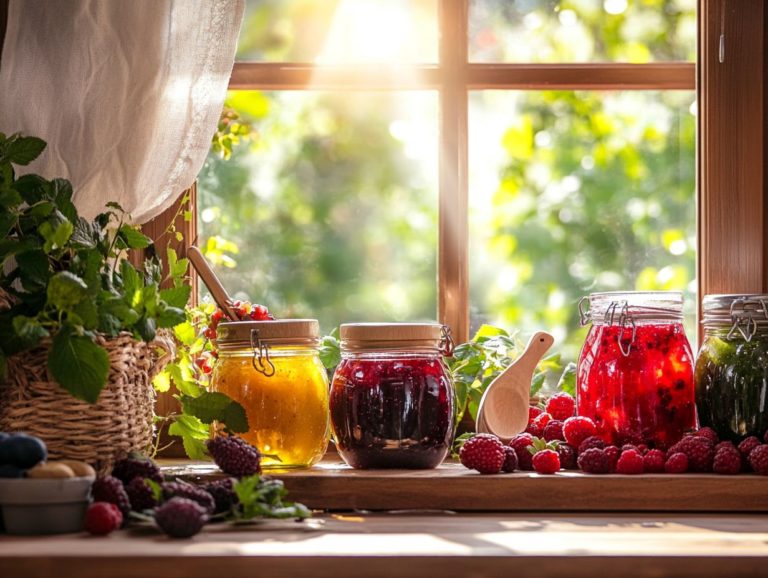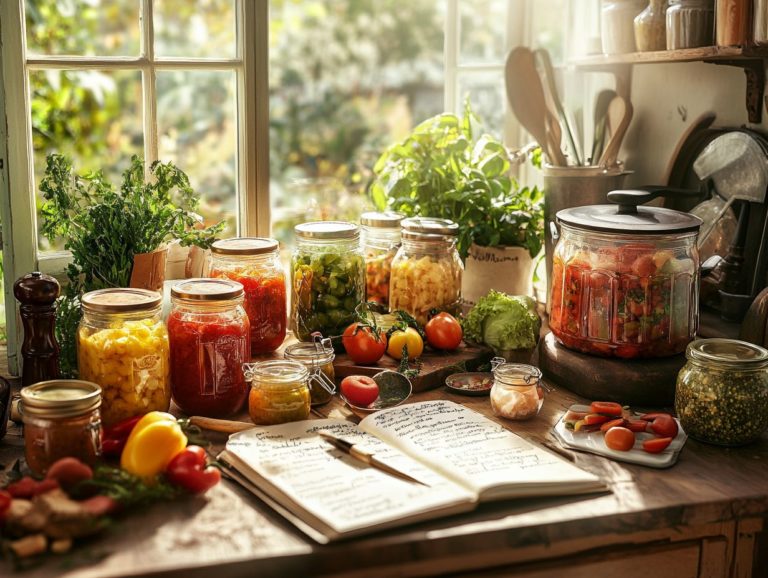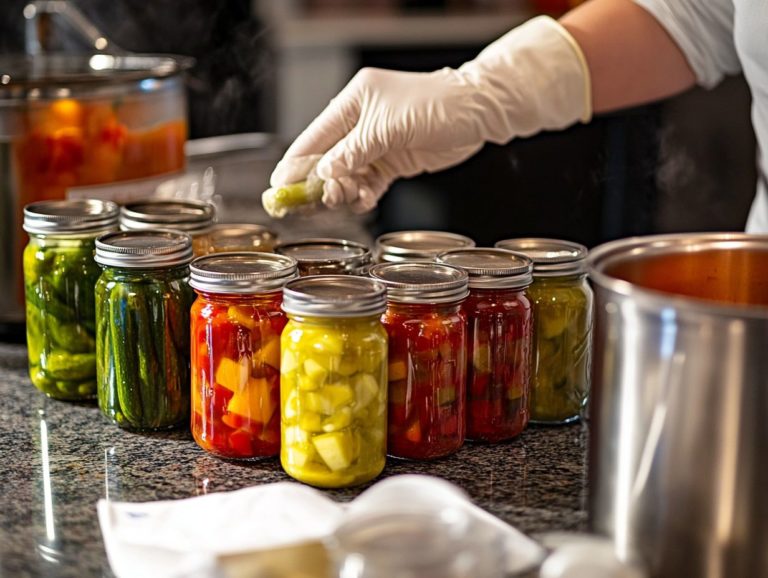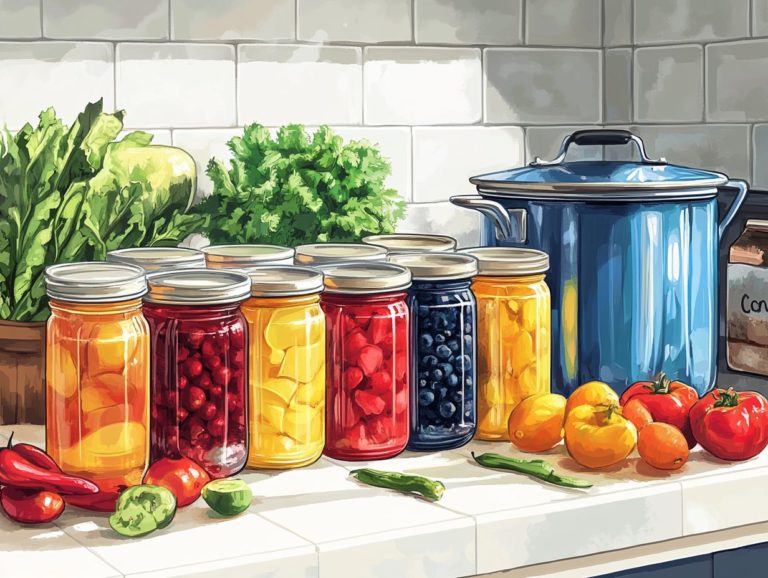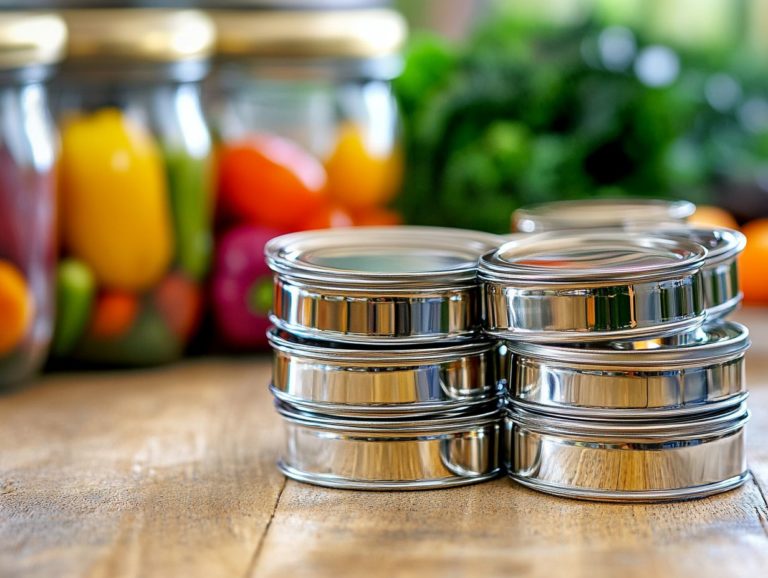Best Practices for Canning on a Budget
Canning at home transcends mere enjoyment; it s a smart way to preserve the vibrant flavors of the season while mindfully managing your budget.
This article delves into the essential tools and equipment you ll need for successful canning without breaking the bank. It highlights cost-effective ingredients, from seasonal produce to innovative ways to repurpose leftovers.
You ll also find valuable tips on maximizing shelf life and organizing your pantry for seamless access. Prepare to indulge in delightful homemade preserves while keeping your finances in check!
Contents
- Key Takeaways:
- Choosing the Right Equipment
- Cost-Effective Ingredients for Canning
- Maximizing Shelf Life and Storage Space
- Frequently Asked Questions
- What are some best practices for canning on a budget?
- Is it safe to reuse jars and lids for canning on a budget?
- What types of produce are best for canning on a budget?
- Can I save money on canning equipment?
- What are some tips for finding affordable canning supplies?
- Are there any safety precautions I should take when canning on a budget?
Key Takeaways:
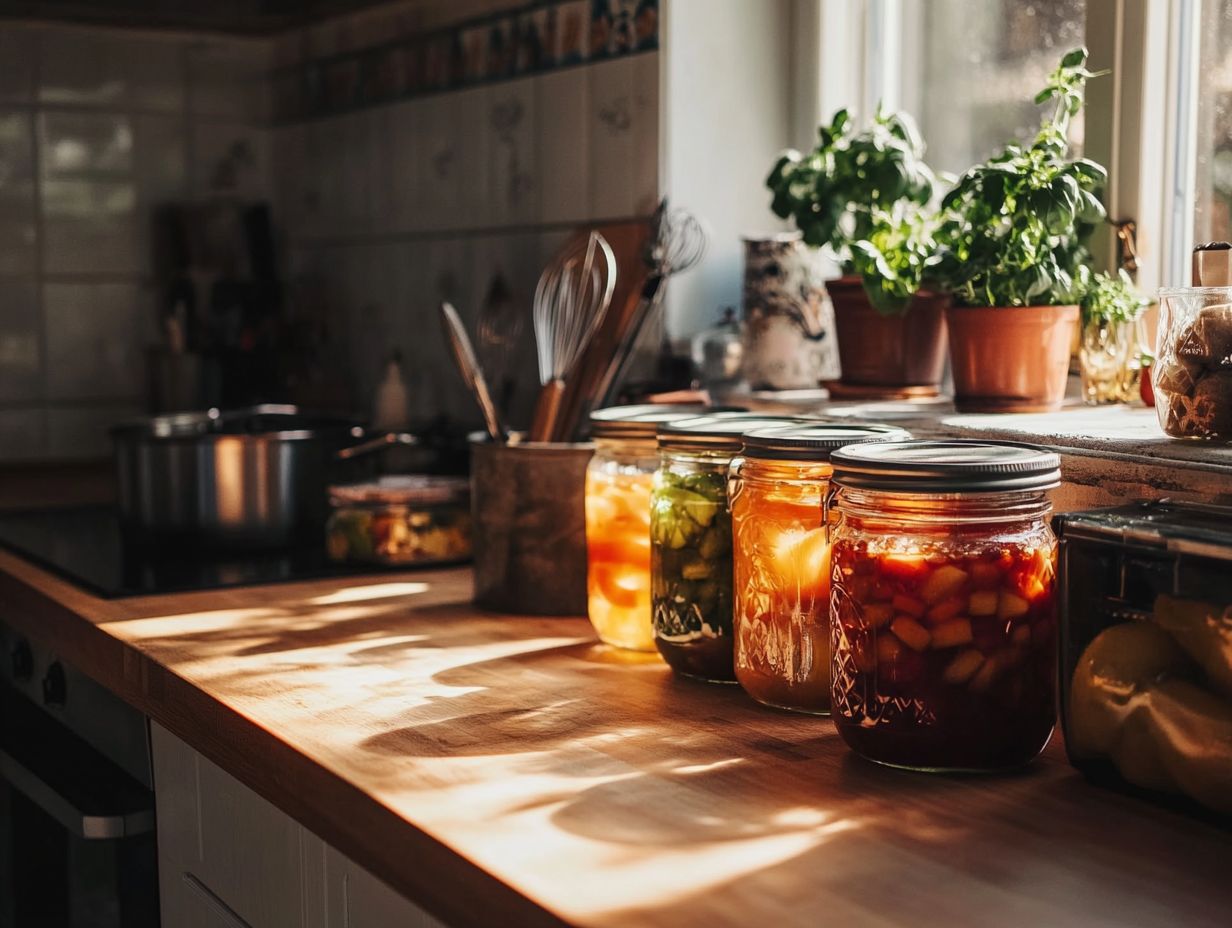
- Save money by canning at home with budget-friendly equipment and ingredients.
- Use seasonal produce and leftovers to keep costs low while still creating delicious canned goods.
- Properly seal and store jars to maximize shelf life and efficiently organize your canned goods.
Benefits of Canning at Home
Canning at home is not just a practical way to preserve food; it s a rewarding endeavor that offers numerous benefits extending far beyond simple sustenance.
This time-honored preservation technique allows you to dive into a world of flavors. You can savor the bounty of seasonal ingredients throughout the entire year. You’ll love how much you can save by using local produce when it’s plentiful and cheaper, steering clear of those inflated prices for out-of-season items.
The health benefits of home canning are undeniable. By skipping the preservatives and additives commonly found in store-bought alternatives, you can enjoy a cleaner, more nutritious option right from your kitchen. This hands-on approach not only sparks creativity but also strengthens family ties, turning the ordinary task of food prep into delightful bonding moments as everyone gets involved in the process.
Why Budget Matters
Understanding the importance of budgeting in canning is crucial for maximizing your investment in homemade food preservation. By following the do’s and don’ts of canning, you can carefully plan and manage your expenses, reaping the benefits of canning without overspending, ensuring you have access to quality ingredients, tools, and equipment.
A well-structured budget helps you prioritize essential purchases like jars, lids, and high-acid vegetables, making the entire process both economical and enjoyable, especially when you explore canning techniques for local ingredients.
To create an effective financial plan, start by assessing your needs and estimating the total cost of your project. This should encompass not just the ingredients, but also any necessary equipment, such as pressure cookers or canning pots. If you’re interested in home canning, consider checking out best practices for preserving fruits. By concentrating on essential purchases first, you can sidestep unnecessary expenses. This method can lead to significant savings over time, as preserving food at home often proves to be less costly than buying similar products at the store.
Implementing budgeting strategies, like setting aside a small amount each month specifically for your canning projects, can further encourage smarter spending and foster a sense of financial discipline. For those new to this practice, understanding canning techniques for beginners can also help avoid common pitfalls.
Choosing the Right Equipment
Selecting the right equipment for canning is essential for ensuring both safety and efficiency in your food preservation endeavors. You ll want to consider a range of tools and machines, including pressure canners, stock pots, and specialized canning jars, to make certain that the process flows smoothly and securely.
High-quality lids and accessories like funnels and tongs are key to preventing contamination and achieving a proper seal, ultimately protecting your homemade creations. By investing in the right canning equipment, you not only elevate your experience but also ensure the successful preservation of a diverse array of high-acid foods, like tomatoes and fruits, which are easier to can safely, and low-acid foods.
Essential Tools for Canning on a Budget

Equip yourself with essential tools for canning on a budget. For tips on maximizing your efforts, check out how to make the most of your canning season, which can significantly elevate your food preservation experience.
Key items like a pressure canner and stock pot are affordable while still delivering quality performance. Handy tools such as tongs and funnels can also be found at reasonable prices.
Investing in durable jars and lids is crucial for long-term use. This allows your canning efforts to produce delightful homemade recipes without straining your finances.
To uncover the best deals, explore local thrift stores, garage sales, or online marketplaces where second-hand equipment is often available at a fraction of the retail price.
Purchasing in bulk can lead to substantial savings over time. It’s wise to keep an eye out for seasonal sales and promotions during peak canning season to maximize your investment with canning techniques for using up surplus produce.
By prioritizing functionality and durability over luxury brands, you ll establish a reliable canning setup that meets your needs without overspending.
Alternative Equipment Options
Exploring alternative equipment options for canning opens up exciting new avenues to preserve food without the burden of expensive specialized tools.
A large stock pot can effectively substitute for a traditional canner, letting you whip up homemade recipes with minimal investment. Understanding safety protocols is crucial when using alternative equipment to ensure proper sealing.
Utilizing a kitchen timer helps monitor cooking times accurately. Funnel guides assist in transferring ingredients without spills.
A simple food processor can prepare your fruits and vegetables quickly. Investing in basic jars with airtight lids enhances your preservation process, keeping your homemade sauces and jams fresh for longer.
Opting for DIY canning methods promotes sustainability while encouraging budget-friendly practices. To confidently embrace the art of food preservation, consider these tips for safe canning practices.
Cost-Effective Ingredients for Canning
Using cost-effective ingredients for canning boosts your savings and improves the taste of your preserved foods. Seasonal produce, often available at more affordable prices, presents an ideal opportunity to stock up on ingredients. For more guidance, check out these top canning tips from experts.
Repurposing leftovers creatively minimizes waste while maximizing the effectiveness of your canning endeavors.
Seasonal Produce and Bargain Finds
Seasonal produce presents a wealth of canning opportunities. Grab seasonal fruits and vegetables while they re at their best prices!
When fruits and vegetables are in season, they often come at delightful prices, making them prime candidates for canning. Engage with local markets to create vibrant, homemade recipes that celebrate both flavor and freshness.
Exploring farmers’ markets or joining local farm programs can unveil hidden gems that are both high-quality and cost-effective. Look for ingredients that are firm, blemish-free, and aromatic; these indicate freshness.
This approach enhances the canning experience. It also supports local economies and reduces transportation carbon footprints.
Ultimately, embracing seasonal produce enriches the taste of your preserves. It fosters a deeper appreciation for the changing seasons and their bountiful offerings.
How to Use Leftovers in Canning
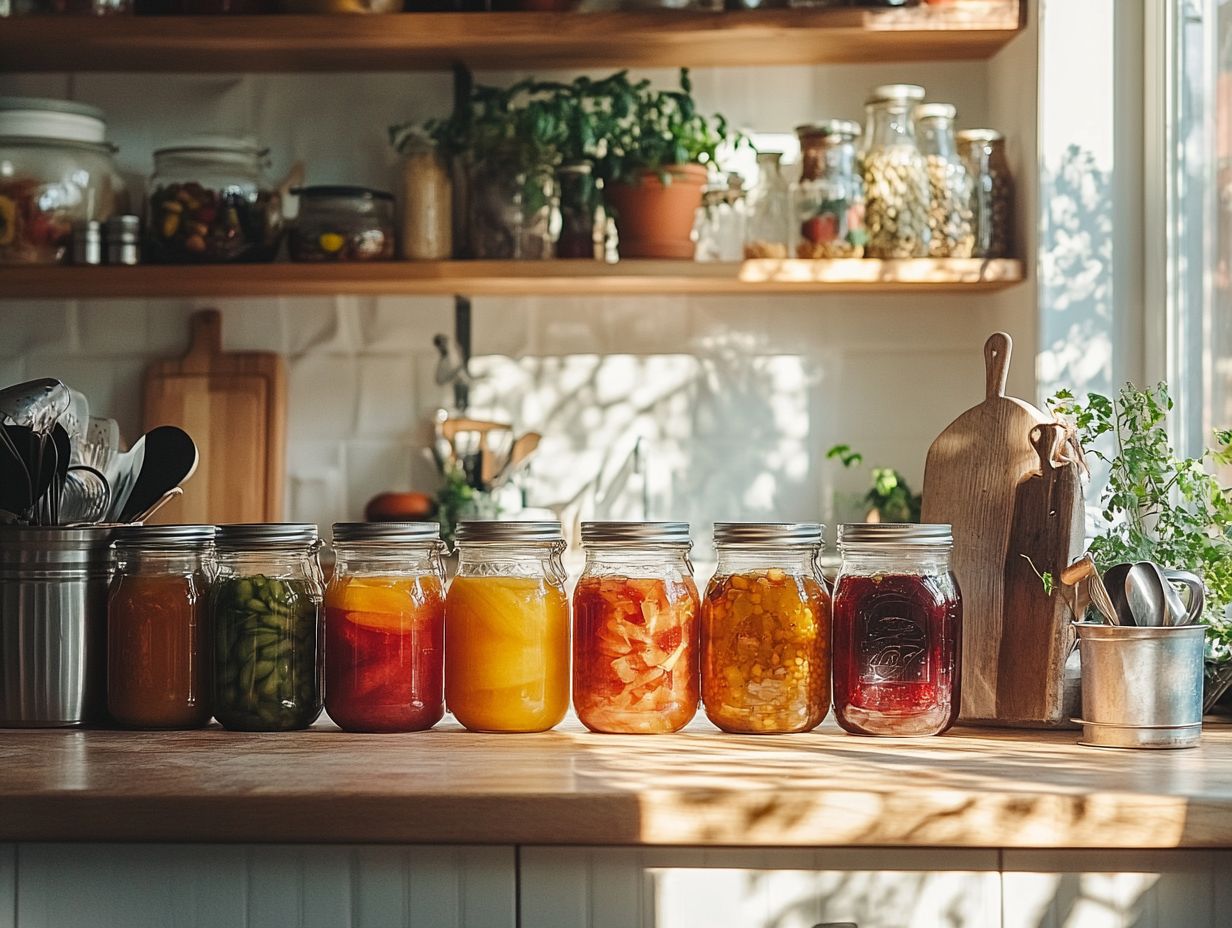
Using leftovers in canning helps you reduce food waste and opens the door to creative culinary experimentation. Transforming leftover vegetables and other ingredients into preserved goods allows you to craft unique homemade recipes that deliver delicious flavors without extra purchases. This shows how important sustainability and resourcefulness are in food preservation.
Repurposing excess produce lets you create vibrant relishes, savory salsas, or even sweet jams that capture the essence of seasonal flavors. Techniques like pickling and making chutneys elevate these ingredients, turning them into delightful, shelf-stable treats. Adding spices and herbs can enhance the taste, making each jar a delightful exploration of flavors.
This approach cultivates an appreciation for seasonal produce and encourages mindful cooking practices. It ultimately leads to a more sustainable kitchen environment. Canning leftovers shifts your perspective on food, ensuring nothing goes to waste while celebrating your culinary creativity.
Maximizing Shelf Life and Storage Space
Maximizing shelf life and storage space for your canned goods is vital to preserving their quality and safety. Using proper sealing techniques like ensuring a snug fit on jar lids and storing them under optimal conditions greatly extends the usability of your canned food.
Organizing your storage area helps you fully utilize available space. This ensures that everything is easily accessible when you need it.
Tips for Properly Sealing and Storing Jars
Properly sealing and storing your jars is essential for the success and safety of your canning efforts. Make sure the lids are securely fastened and use the right methods for different types of food to prevent spoilage and preserve flavor.
Store your jars in a cool, dark location to enhance preservation. This protects the contents from light and temperature changes while reducing the risk of bacterial growth.
Before storing, check the seals by pressing the center of the lid to see if it’s securely sealed.
Consult guidelines from reliable canning sources to elevate your safety measures. Label your jars with their contents and processing dates to manage your inventory effectively. This helps you consume the oldest jars first and reduces spoilage risk.
Organizing and Managing Canned Goods
Organizing and managing your canned goods is key to maximizing storage space and ensuring easy access to your homemade creations. Develop an inventory system, label jars, and arrange items by type and date to streamline storage.
An effective inventory system can revolutionize how you track what s on hand. Using lists or digital tools enables you to quickly identify what needs to be consumed first, helping prevent waste.
Proper labeling is essential. Include both the contents and the canning date to ensure everything is used within its optimal timeframe. Grouping items like vegetables, fruits, and sauces can speed up the selection process during meal prep.
These strategies enhance accessibility and maximize the usability of your preserved items, transforming home-canned storage into an essential part of your meal planning.
Frequently Asked Questions

What are some best practices for canning on a budget?
Some best practices for canning on a budget include using in-season produce, purchasing in bulk, and reusing jars and lids. To ensure safety and quality, it’s also important to follow the best canning practices.
Ready to start canning? Transform your leftovers into delicious treasures and share your experiences with us!
Is it safe to reuse jars and lids for canning on a budget?
Yes, it’s safe to reuse jars and lids if they are crack-free and chip-free. Just clean and sterilize them before use.
What types of produce are best for canning on a budget?
Choose in-season produce for the best prices. Tomatoes, peaches, and apples are excellent options.
Can I save money on canning equipment?
Absolutely! Look for sales or consider buying used equipment. You can even use things you already have, like a large pot instead of a canning pot.
What are some tips for finding affordable canning supplies?
Check for sales and shop at discount stores. Joining a local canning or gardening group can help you swap supplies with others.
Are there any safety precautions I should take when canning on a budget?
Yes, always follow safe canning practices. Properly sterilize your equipment, use tested recipes, and adhere to recommended processing times and methods.

